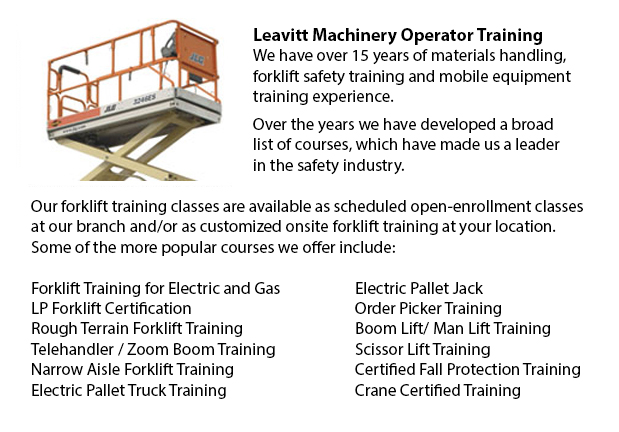
Scissor Lift Certification Surrey - Numerous worksites and tradespeople like for instance welders, masons and iron workers utilize scissor lift platforms to be able to help them reach elevated work areas. The operation of a scissor lift is often secondary to their trade. Therefore, it is important that all operators of these platforms be trained well and licensed. Lift manufacturers, regulators and industry work together to be able to make sure that operators are trained in the safe use of work platforms.
Work platforms are also referred to as manlifts or AWPs. These equipment are stable and simple to use, even though there is always some danger because they lift people to heights. The following are various key safety concerns common to AWPs:
There is a minimum safe approach distance (likewise known as MSAD) for all platforms so as to protect from accidental power discharge due to nearness to wires and power lines. Voltage can arc across the air and cause injury to employees on a work platform if MSAD is not observed.
Care should be taken when the work platform is lowered to guarantee steadiness. The boom should be retracted, if you move the load toward the turntable. This will help maintain stability when the -platform is lowered.
The regulations about tie offs do not mandate people working on a scissor lift to tie themselves off. Some groups would on the other hand, require their personnel to tie off in their employer guidelines, local regulations or job-specific risk assessment. The manufacturer-provided anchorage is the only safe anchorage to which harness and lanyard combinations should be attached.
It is essential to observe and not go beyond the maximum slope rating. The grade can be measured by laying a board on the slope or by laying a straight edge. After that, a carpenter's level can be placed on the straight edge and raised until the end is level. By measuring the distance to the ground and dividing the rise by the straight edge's length, then multiplying by 100, you could determine the percent slope.
A typical walk-around check must be performed to determine if the unit is mechanically safe. A site assessment determines if the work area is safe. This is vital especially on changing construction locations because of the risk of obstacles, unimproved surfaces, and contact with power lines. A function test must be done. If the unit is utilized safely and properly and proper shutdown measures are followed, the possibilities of accidents are greatly reduced.
-
Crane Ticket Surrey
Crane Ticket Surrey - The modern type of a crane could be either complex or simple, and cranes vary based on their application. Mobile cranes, for instance are rather simple. A telescopic boom or steel truss mounts its movable platform. A system of l... More -
Overhead Crane Training Surrey
Overhead Crane Training Surrey - An overhead crane is a large crane made use of to lift and move big, heavy things which cannot be lifted manually. An overhead crane is usually fixed in position when in use. These equipment are capable of moving huge... More -
Manlift Operator Training Surrey
Manlift Operator Training Surrey - A specialized type of hydraulic platform is referred to as an aerial lift or a man lift. It is meant to hoist an individual vertically up and down and therefore, is likewise known as a vertical personnel lift. This... More -
Heavy Equipment Safety Training Surrey
Heavy Equipment Safety Training Surrey - A very essential topic for those who work in industry environments is heavy equipment safety. This particular subject is relevant for people likewise who employ the use of heavy machinery to be able to carry o... More -
Wheel and Track Loader Training in Surrey
Lift trucks are obtainable in a variety of different units which have various load capacities. Nearly all average forklifts utilized inside warehouse environment have load capacities of one to five tons. Bigger scale units are used for heavier loads,... More -
Telehandler Training - Rotational Telehandler, Zoom Boom Training in Surrey
Telescopic handlers often called telehandlers for short, are a very popular piece of heavy construction equipment. They are commonly used in the construction and agricultural industries. These equipments have farthest reaching ability and are able to... More -
Forklift Safety Training Surrey
Forklift Safety Training Surrey - Any individual who wants to operate a forklift must take a forklift safety training course in order to become a certified forklift truck operator. There are various ways to acquire forklift training. Programs are pro... More -
Forklift Operator Training Surrey
Forklift Operator Training Surrey - Forklift training is a prerequisite in North America and is intended to avoid workplace death and injuries. Forklift training offers driver training for forklift operators. Training programs teach the effective and... More

Forklift Training Surrey
TOLL FREE: 1-888-254-6157
forklifttraininginsurrey.com
Email Us
About Us



